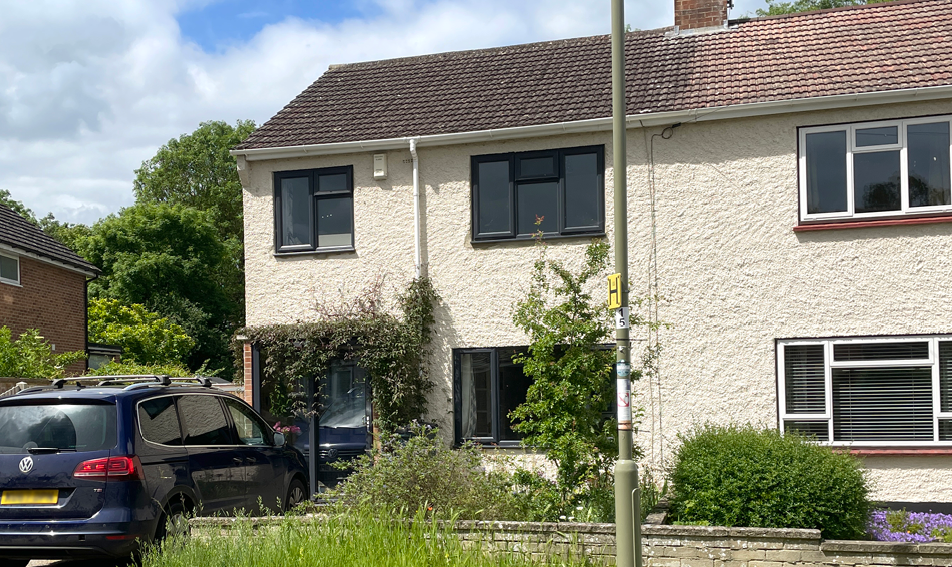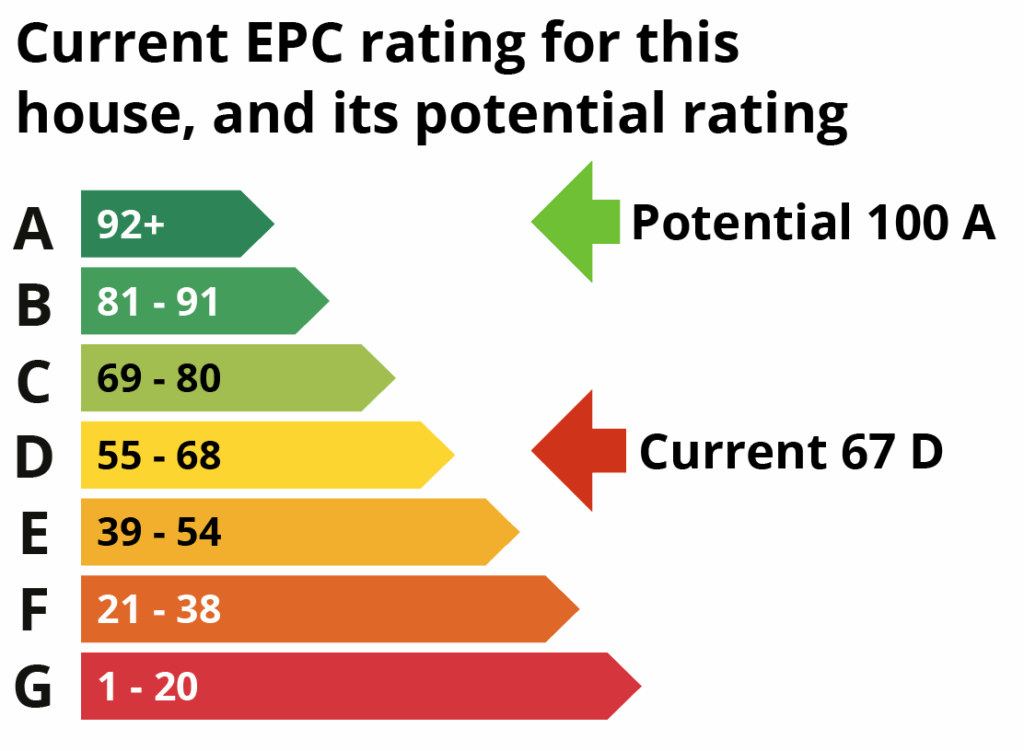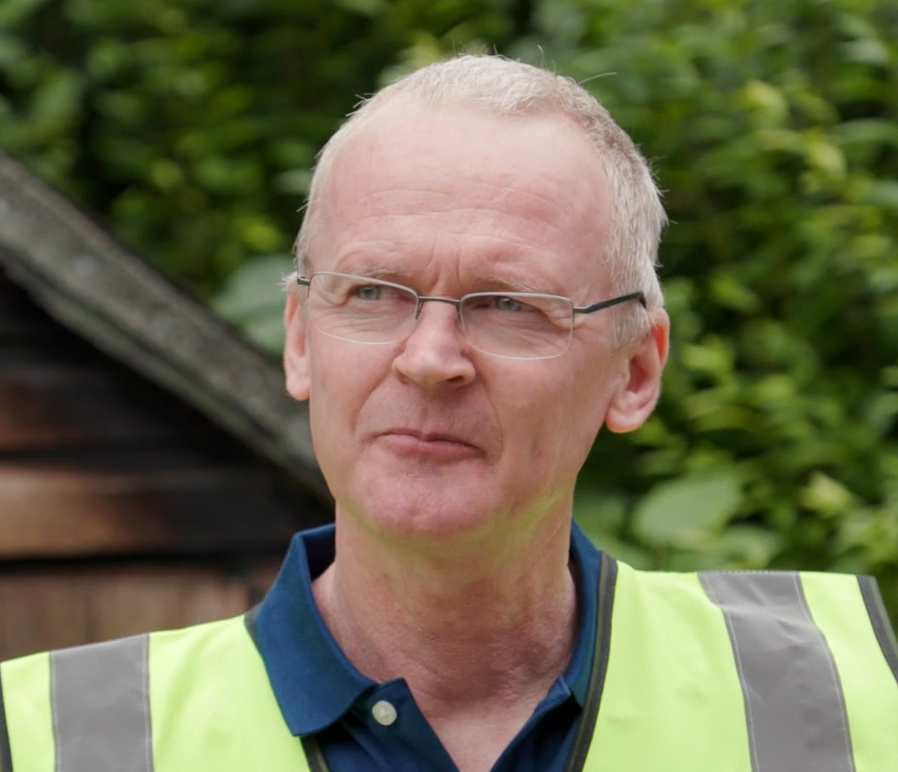
1960s semi-detached home
Could your home be made warmer, cheaper to run, and better for the planet? See what’s possible when you take a whole-home approach to planning energy upgrades.
What’s the potential of a home like this?
This 1960s semi-detached home in Oxford is typical of thousands built during the period. With cavity walls, solid floors, and a pitched roof, it was struggling with heat loss and rising energy costs.

The owners wanted to understand the smartest way to improve comfort without overspending. With a Whole House Plan, they could see how to stage upgrades – cutting carbon, lowering bills, and making the home fit for the future.
Here’s what the plan revealed:
| Carbon emissions could be cut by over 90% |
| The EPC rating could rise from 62 D to 93 A |
| Annual fuel bills could fall by more than half |
You don’t have to carry out every measure at once. The Whole House Plan gives you a roadmap so you can make improvements in your own time, at your own pace, and within your budget.

“The Whole House Plan was extremely helpful. It provided a detailed cost breakdown and will help us prioritise our next steps. This advice was far better than the fragmented input from tradespeople, who just focus on their specific projects rather than take a whole house approach.”
Louise, Marston, Oxford
Where this home stands now
House profile
| EPC rating | Current 62 D > Potential 93 A |
| Type | Semi-detached |
| Built | 1960s |
| Location | Oxford |
| Occupancy | Owner-occupied |
| Bedrooms | 3 |
| Floor area | 89m² |
| Walls | Cavity, unfilled |
| Floors | Solid |
| Roof | Pitched with loft |
| Windows | Double glazed, uPVC |
| Annual energy use | 16,076 kWh (181 kWh/m²) |
| Carbon emissions | 3.04 tonnes CO2/year |
The EPC rating: now vs potential

An EPC rates your home’s energy efficiency – from A (best) to G (worst). A higher score can mean lower bills, but it doesn’t guarantee comfort. Whole-home upgrades help bridge that gap.
Long-term comfort, short-term disruption
| Key to tables: | Low impact: • | High impact: •••••• |
| Minor measures | Comfort & health | Disruption |
|---|---|---|
| Low energy lighting | ● | ● |
| Increase loft insulation to 300mm | ●●●● | ●● |
| Insulate and draught-proof loft hatch | ●●●● | ● |
| Cavity wall insulation | ●●●● | ●● |
| New insulated front door | ●●●●● | ●● |
| Ventilation improvements | ●●●●● | ●● |
| Major measures | Comfort & health | Disruption |
|---|---|---|
| External wall insulation | ●●●●● | ●●● |
| Solid floor insulation | ●●●●● | ●●●● |
| New triple-glazed windows | ●●●●●● | ●●●● |
| Air source heat pump | ●●●●●● | ●●●● |
| Measure | Comfort & health | Disruption |
|---|---|---|
| Solar PV | ● | ●● |
Expert tip

“Mould growth on bedroom ceilings usually indicates cold surface temperatures that need to be addressed. Increasing loft insulation and ensuring it overlaps with cavity wall insulation at the eaves is important. As lofts become more insulated it’s vital that the space above the insulation is properly ventilated so that the roof timbers remain dry and free from rot.”
Geordie Stewart, Scheme Manager
The difference each step could make
These figures show how each recommended measure could affect the home’s EPC rating, energy bills, and carbon emissions – if installed in the order shown. They’re based on a full Whole House Plan tailored to this property.
| Measure | Est. cost | EPC | Fuel bill | CO₂/year |
|---|---|---|---|---|
| Where you are now | – | 62 D | £1,120 | 3.04 t |
| Loft insulation to 300mm | £1.5k–£2k | 64 D | £1,059 | 2.88 t |
| Cavity wall insulation | £2.1k–£2.7k | 66 D | £1,014 | 2.76 t |
| External wall insulation | £22.5k–£27k | 71 C | £881 | 2.40 t |
| Triple glazed windows | £10.5k–£15k | 74 C | £770 | 2.10 t |
| New insulated doors | £2.1k–£2.7k | 74 C | £757 | 2.06 t |
| Ventilation improvements | £1.5k–£2k | 74 C | £757 | 2.06 t |
| Solid floor insulation | £11k–£14k | 76 C | £697 | 1.90 t |
| Air source heat pump | £7.5k–£12.5k | 84 B | £563 | 0.33 t |
| Solar PV (3 kWp) | £4.5k–£6k | 93 A | £452 | 0.19 t |
Boost your EPC rating
Installing a single major system like a heat pump or solar panels can still make a big difference. These examples show how individual upgrades could shift the home’s EPC and reduce carbon emissions – even before doing everything else.
| Upgrade option | EPC rating | Fuel bill | CO₂ emissions |
|---|---|---|---|
| Just solar PV | 80 B | £618 | 2.49 t |
| Just heat pump | 75 C | £906 | 0.53 t |
| Solar + heat pump | 87 B | £520 | 0.27 t |
Expert tip

“External wall insulation is ideal for houses where the walls are rendered because it doesn’t change the appearance. Louise and her husband are planning a new rear extension and this would be a great time to incorporate wall insulation on the main house.”
Natasha Ginks, Retrofit Coordinator
Wondering what’s right for your home?
A Whole House Plan gives you expert, independent advice on the best steps to take – and in what order – so every upgrade really works.
Don’t put it off another year. Take the first step with a free consultation. Our team of experienced Retrofit Advisers will listen to your goals, help you understand what’s possible, and outline the best next steps – no pressure, no obligation.
Smarter home upgrades. Backed by trusted retrofit expertise.

A partnership project
A House Like Mine is an Oxford City Council initiative, delivered as part of the Zero Carbon Oxford Partnership (ZCOP) in collaboration with Cosy Homes Oxfordshire. The idea was first developed through case studies in Charlbury, and has since been expanded to show what’s possible for homes across Oxford and Oxfordshire.
It’s designed to help you take the first step towards making your home cosy, energy-efficient, and ready for the future. Step by step.
A House Like Mine was funded by the MCS Foundation, Oxfordshire County Council, Oxford City Council, and Lucy Group. The case studies are licensed under a Creative Commons BY-NC-ND 4.0 licence (creativecommons.org).

Prefer a PDF version?
Download a shareable PDF of this case study – perfect for your community group, local class, or anyone curious about improving home energy efficiency.
We’re making this resource freely available to raise awareness of how retrofitting – upgrading your home to use less energy and stay comfortable year-round – can make a real difference.
Click here to download the PDF
